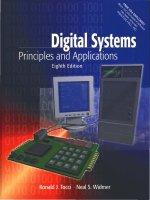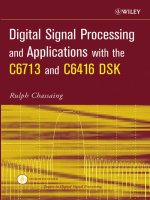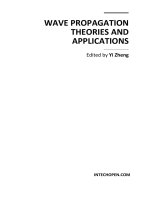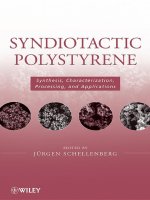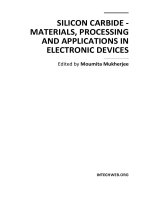TUNGSTEN CARBIDE – PROCESSING AND APPLICATIONS doc
Bạn đang xem bản rút gọn của tài liệu. Xem và tải ngay bản đầy đủ của tài liệu tại đây (22.68 MB, 146 trang )
TUNGSTEN CARBIDE –
PROCESSING AND
APPLICATIONS
Edited by Kui Liu
Tungsten Carbide – Processing and Applications
Edited by Kui Liu
Contributors
I. Borovinskaya, T. Ignatieva, V. Vershinnikov, A.K. Nanda Kumar, Kazuya Kurokawa, Marcin
Madej, Zbigniew Pędzich, Paweł Twardowski, Szymon Wojciechowski, Yufeng Fan
Published by InTech
Janeza Trdine 9, 51000 Rijeka, Croatia
Copyright © 2012 InTech
All chapters are Open Access distributed under the Creative Commons Attribution 3.0 license,
which allows users to download, copy and build upon published articles even for commercial
purposes, as long as the author and publisher are properly credited, which ensures maximum
dissemination and a wider impact of our publications. After this work has been published by
InTech, authors have the right to republish it, in whole or part, in any publication of which they
are the author, and to make other personal use of the work. Any republication, referencing or
personal use of the work must explicitly identify the original source.
Notice
Statements and opinions expressed in the chapters are these of the individual contributors and
not necessarily those of the editors or publisher. No responsibility is accepted for the accuracy
of information contained in the published chapters. The publisher assumes no responsibility for
any damage or injury to persons or property arising out of the use of any materials,
instructions, methods or ideas contained in the book.
Publishing Process Manager Sandra Bakic
Typesetting InTech Prepress, Novi Sad
Cover InTech Design Team
First published December, 2012
Printed in Croatia
A free online edition of this book is available at www.intechopen.com
Additional hard copies can be obtained from
Tungsten Carbide – Processing and Applications, Edited by Kui Liu
p. cm.
ISBN 978-953-51-0902-0
Contents
Preface VII
Chapter 1 Self-Propagating High-Temperature Synthesis
of Ultrafine Tungsten Carbide Powders 1
I. Borovinskaya, T. Ignatieva and V. Vershinnikov
Chapter 2 Spark Plasma Sintering of Ultrafine WC Powders:
A Combined Kinetic and Microstructural Study 21
A.K. Nanda Kumar and Kazuya Kurokawa
Chapter 3 Tungsten Carbide as an Addition
to High Speed Steel Based Composites 57
Marcin Madej
Chapter 4 Tungsten Carbide as an Reinforcement
in Structural Oxide-Matrix Composites 81
Zbigniew Pędzich
Chapter 5 Machining Characteristics of
Direct Laser Deposited Tungsten Carbide 103
Paweł Twardowski and Szymon Wojciechowski
Chapter 6 Fabrication of Microscale Tungsten Carbide Workpiece
by New Centerless Grinding Method 121
Yufeng Fan
Preface
Tungsten carbide (WC) was first extracted from steel and properly identified around
mid 19
th
century. It has attracted great interest to both engineers and academics for the
sake of its excellent properties such as hard and wear-resistance, high melting point
and chemically inert. Although it has been known for over one hundred years,
recently tungsten carbide has been applied in numerous important industries
including aerospace, oil and gas, automotive, semiconductor and marine, which also
has a promising future. Cemented tungsten carbide, often simply called carbide, and
also called cemented carbide and hard-metal, is a metal matrix composites (MMCs)
where tungsten carbide particles are the aggregate and metallic cobalt serves as the
matrix. It has excellent physicochemical properties, particularly enables to resist high
temperatures and is extremely hard, which bring out wide application in the industry
for cutting and mining tools, moulds and dies, and wear parts.
This book aims to provide fundamental and practical information of tungsten carbide
from powder processing to machining technologies for industry to explore more
potential applications. Chapter 1 introduces the self-propagating high-temperature
synthesis (SHS) method to produce nanosized tungsten carbide powder. Chapter 2
explores the kinetic mechanism for spark plasma sintering (SPS) of tungsten carbide
nanosized powder to produce cemented carbide. Chapters 3 and 4 are dedicated to
production of metal/ceramic matrix composites with enhanced mechanical properties
using tungsten carbide particle as a reinforcement phase. Chapter 5 is dedicated to the
machinability investigation of cemented tungsten carbide, which could expand their
application areas by making components using novel machining technologies. The last
chapter presents an ultrasonic vibration shoe centerless grinding technology for
tungsten carbide component manufacturing.
The book can serve as an informative reference for academics, researchers, engineers
and professional that are related to tungsten carbide processing and applications.
The editor would like to thank InTech for this opportunity and their enthusiastic and
professional support. Finally, I sincerely thank all the authors for their contributions to
this book.
Dr. Kui Liu
Singapore Institute of Manufacturing Technology,
Singapore
Chapter 1
© 2012 Ignatieva et al., licensee InTech. This is an open access chapter distributed under the terms of the
Creative Commons Attribution License ( which permits
unrestricted use, distribution, and reproduction in any medium, provided the original work is properly cited.
Self-Propagating High-Temperature Synthesis
of Ultrafine Tungsten Carbide Powders
I. Borovinskaya, T. Ignatieva and V. Vershinnikov
Additional information is available at the end of the chapter
1. Introduction
Transition metal carbides, particularly tungsten carbide, are rather attractive due to
their physical and mechanical properties [1]. They are characterized by the high melting
point, unusual hardness, low friction coefficient, chemical inertness, oxidation resistance,
and excellent electric conductivity. Nowadays, highly dispersed tungsten carbide
powders appear to be very important for production of wear-resistant parts, cutters,
non-iron alloys, etc.
It is well known, that fine-grained alloys demonstrate better mechanical properties in
comparison with coarser alloys of the same composition under the same terms [2-4]. Use of
ultrafine or nanosized powders is one of the most efficient ways to produce new materials
with required properties.
That is why nowadays the production technologies of nanopowders play the leading role
among the widely used directions.
There are several phases of tungsten carbide; the most important ones are WC and W
2C [5].
Though W
2C is unstable at T=1300°C, in most cases the mixture of WC and W2C is observed
in the synthesis products. Precipitation of the single phase of WC is only possible in the
narrow area of the technological parameters [6].
There are different ways to obtain tungsten carbide powders, and each process changes the
characteristics of the forming product.
Tungsten carbide powders are obtained by direct carbonization of tungsten powder. This
process implies production of pure highly dispersed powder of metal tungsten within the
first stage. The initial material in this case is very pure WO
3, tungsten acid or ammonium
tungstate [7-9].
Tungsten Carbide – Processing and Applications
2
The second stage includes carbonization of tungsten by carbon in the graphite furnace with
hydrogen atmosphere. Depending on the type of the furnace, atmosphere, and carbon
content the reaction occurs according to the scheme:
2W + C → W
2C
or
W + C → WC.
The obtained tungsten carbide powder has particles of the indefinite melted form, minimum
3 – 5 μm in size and contains 5 % of W
2C minimum. The reduction terms greatly influence
the characteristics of the metal powder and forming carbide.
Thermochemical synthesis of nano-phased tungsten carbide powders was also studied. It
consisted of two stages [10, 11]. At first, nano-phased powders of metal tungsten were
synthesized by reduction of various tungsten salts and chemical decomposition of vapor of
volatile tungsten compounds. Then nano-phased tungsten carbide with the particle size of
~30 nm was obtained by carbonization at low temperature in the medium of controlled
active carbon-containing gas phase.
The method suitable for tungsten carbide synthesis at low temperatures (~800°C) during 2
hours was suggested [12]. It is based on the gas-solid reaction between a tungsten source
(ammonium paratungstate or tungsten oxide) and carbon-containing gas phase which
includes a mixture of H
2 and CH4.
The conventional calcination–reduction–carburization (CRC) process offers the potential to
manufacture commercial tungsten carbide powders with median grain sizes below 0.5 μm
(ultrafine grades) [13].
In [14] point to that transferred arc thermal plasma method is more economical and less
energy intensive than the conventional arc method and results in a fused carbide powder
with higher hardness. Coatings of high wear resistance can be produced using fused
tungsten carbide powder with WC and W
2C phases, which can be economically synthesized
by thermal plasma transferred arc method [14].
However, it is not economically efficient to use very pure and fine tungsten powder
obtained from tungsten compounds at the stage of its reduction for producing a large
quantity of tungsten carbide powder.
The existing economical and technological restrictions make the problem of the
development of large-scaled cheap production of ultrafine and nanosized tungsten carbide
powders very actual. Nowadays, a promising ecologically safe method, discovered in 1967
by academician A.G Merzhanov and his co-workers I.P. Borovinskaya and V.M. Shkiro –
Self-propagating High-temperature Method (SHS) – is used for obtaining refractory
compounds of high quality. This method combines a simple technology with low power
consumption and allows obtaining products with regulated chemical and phase
Self-Propagating High-Temperature Synthesis of Ultrafine Tungsten Carbide Powders
3
composition and dispersion degrees. Therefore the possibility of application of SHS
technology for preparing ultrafine and nanosized tungsten carbide powders represented
practical interest.
2. Experimental
2.1. Self-propagating high-temperature synthesis (SHS)
The new scientific direction SHS was developed at the interface of three scientific fields:
combustion, high-temperature inorganic chemistry and materials science. SHS is an
autowave process analogous to propagation of the combustion wave with the chemical
reaction being localized in the combustion zone propagating spontaneously along the
chemically active medium [15, 16]. The essence of the process is occurrence of exothermic
reactions at temperatures developing as a result of self-heating of the substance; the
synthesis temperature is up to 4000°C, the temperature growth rate – 10
3
-10
6
K/s, the
combustion velocity – 0.1-10 cm/s.
Thorough fundamental investigations of the SHS process have proved that chemical
transformation in combustion waves and product structure formation occur simultaneously
with high velocity and at significant temperature gradients. These peculiarities of the
process provide practically complete chemical transformation of the mixture and a specific
structure of the combustion products. Application of SHS allows avoiding the main
disadvantages of conventional technological processes – high power consumption,
complicated equipment, low product output.
The extreme terms which are characteristic of SHS of chemical compounds affect chemical
and phase composition of the products as well as their morphology and particle size [17, 18].
The experiments in product quenching by special cooling methods immediately after the
combustion front propagation have proved that “primary” product particles of 0.1-0.2 μm in
size can be formed in the combustion front [19, 20].
The product structure formation during the chemical reaction was called primary structure
formation while the structure formed in this case was called the primary structure of the
product. The characteristic time of the chemical reaction is 10
-3
-10
-1
s; the time of the primary
structure formation being the same. After the chemical reaction the particle size increases as
a result of the secondary structure formation process followed by collecting recrystallization
[21]. The duration of the process depends on the sample cooling mode and is usually about
some or tens seconds.
Transformation of initial reagents to final SHS products is a complicated multiparametric
process. There are various ways to govern it. The main types of the occurring processes are
solid-flame combustion in the solid-solid system (one of the varieties is combustion with the
intermediate melted layer), gas-phase SHS (chain flames, combustion of condensed systems
with gaseous intermediate zone), combustion of solid-gas systems (filtration combustion,
combustion of gaseous suspensions) [22].
Tungsten Carbide – Processing and Applications
4
Let us consider the possibilities of these processes.
In order to obtain ultrafine and nanosized products in the processes of solid-flame
combustion, one must use the reagents of the same dispersion. In solid-phase systems with
the intermediate melted layer the possibility of nano-crystal formation depends on
crystallization and recrystallization processes, combustion heat modes and product cooling
after the reaction.
In the case of gas-phase SHS (gas combustion followed by a condensed product formation)
the product elemental particles consolidate with each other and form nuclei on the surface
of which the following reactions occur. If fast artificial cooling is used, it is possible to arrest
the particle size growth at a required stage and obtain nanopowders by depositing the
particles from the gas mixture.
At gas-phase combustion the initial reagents, intermediate and final compounds remain in
the condensed state (either liquid or solid) during the entire reaction [16, 23].
The SHS method has provided the possibility of obtaining a great number of compounds in
the dispersed state (powder). Among the materials for which the technological backgrounds
are well developed the main ones are powders of refractory compounds. They are widely
used in industry due to their outstanding properties such as hardness, thermal stability,
abrasive wear and resistance.
There are several directions of the SHS technologies. The widest and well-developed type of
SHS reactions is the synthesis reactions of refractory compounds from elements. It is
oxygen-free combustion. Both powders and gaseous elements take part in the chemical
reactions. Besides, some regulating additions R are introduced into the initial mixture. They
can be synthesis products (as diluents), various inorganic and organic compounds.
Another direction is combination of SHS with thermal reduction (SHS with a reducing
stage) when the compounds of elements (oxides, halogenides, etrc.) and metal-reducers –
Mg, Ca, Al, Zn, etc. are used for the synthesis. The advantages of this method are a low price
and availability of raw materials. Besides, metallothermal powders are characterized by
such valuable properties as high dispersion and homogeneous granulometric composition.
The interaction of the reagents in the combustion wave occurs within two stages. The first
one (reduction of the main metal oxide) is a metalthermal reaction. The second stage (SHS
itself) is the interaction of the reduced metal with a non-metal followed by a refractory
compound formation. There are a lot of secondary reactions which should be suppressed
when optimum technological terms of the process are worked out. In the complicated
systems of oxide – metal-reducer – carbon (hydrocarbon), carbon-containing components
take part in carbide formation and reduction of metal oxides as well. It defines the
requirements to the choice of the initial components ratio.
As a result of the SHS with a reducing stage a “semiproduct” is obtained which contains the
main compound and the secondary products which can often be metal-reducer oxides. In
metallothermic powders the secondary product is distributed uniformly in the whole
Self-Propagating High-Temperature Synthesis of Ultrafine Tungsten Carbide Powders
5
volume of the reactive mass. So it is necessary to carry out some additional operations to
sort out the main compound [24, 25].
Having analyzed the literature data, we can conclude that in the case of the development of
the SHS technology of tungsten carbide the main attention should be paid to detection of the
terms of nano-particle formation during the synthesis process. However, investigation of the
separation methods of chemically pure ultrafine and nanosized compounds from the
synthesis products and their analysis are very important too.
2.2. Chemical dispersion
SHS products are cakes or ingots which should be processed for obtaining powders. It can
be achieved by either mechanical milling or chemical treatment.
Mechanical milling (conventional milling by balls, friction milling, planetary milling) is the
easiest method for obtaining ultrafine and nano-sized powders. It is possible to obtain fine
powders (up to 10-20 nm), but the problems of the long duration of the process, powder
contamination with the ball and vessel materials, high power consumption require some
additional solution.
One of the promising methods of obtaining nano-sized powders is the method microparticle
dissolution. Recently, the efficiency of the dissolution processes for converting microparticle
size to the nano-level has been confirmed. The method is based on the property of particles
to decrease their volume uniformly due to their dissolution in acid and alkali media. But
simultaneously the structure and the properties of the central part of the substance or phase
remain the same [26].
The main aim of powder application is to obtain a dense product with homogeneous
microstructure after compaction. The common reason restricting the refractory material
strength is existence of agglomerates in the powder [27]. So in order to make the powder
strong, it is necessary to disintegrate or remove large solid agglomerates from the initial
powder. In the case of ultrafine powders the agglomerates are disintegrated by dispergating
and milling in suitable solutions.
The influence of various solutions on the powder structure, dispersion degree and specific
surface area has been already studied for SHS powders of boron nitride and aluminum
nitride.
After synthesis, the materials were mechanically disintegrated and subjected to
thermochemical treatment in neutral, acid, and alkali media at temperatures ranging from
20 to 100°C [28]. Such treatment is termed “chemical dispersion” of SHS products, as
suggested by Merzhanov [29]. Chemical dispersion in a neutral medium resulted in
increased total, outer, and inner specific surfaces. Mean grain size decreased. This implies
that chemical dispersion provided for disintegration of the materials, as well as leading to
formation of new channels and pores and the appearance of new defects, finally resulting in
improved specific surface.
Tungsten Carbide – Processing and Applications
6
In [25] describes thoroughly the application of chemical dispersion for separating ultrafine
and nanosized powders of boron nitride obtained by various methods under the SHS mode:
from elements, with participation of boron and boron oxide, and from boron oxide with the
stage of magnesium reduction.
Possible production of tungsten carbide of ultrafine and nanosized structure by the SHS
technology with a reducing stage with using chemical dispersion for separation of
submicron powders was of great practical interest.
This paper demonstrates the investigation results of the dependence of SHS tungsten
carbide powder dispersion on the SHS process parameters and composition of the solutions
used for chemical dispersion of the synthesis products and separation of the final product.
The aim is producing single phase tungsten carbide with ultrafine and nanosized structure.
2.3. Experiment description and products characterization
The starting materials used were 99,98+%-pure WO3 with an average particle size of 10-12
μm (commercially available material which is used in the production of hard alloys), P804-T
furnace black less than 45 μm in particle size, and I.PF-1 magnesium powder (99.1+%)
ranging from 0.25 to 0.50 mm in particle size.
To mix the components and grind the SHS products, we used ball mills with steel grinding
media. Synthesis was carried out in a 30-l SHS reactor under argon atmosphere.
To prepare tungsten carbide, we used the exothermic reaction between tungsten oxide,
carbon (black), and magnesium metal:
WО
3 + Mg+ С + R → WC∙MgO∙Mg + R’+ Q (1)
where R is a regulating additive.
The temperature of this process exceeds 3000°C; it can cause decomposition of the
forming tungsten carbide. To reduce the combustion temperature, we introduced different
additives, inert or decomposing in the combustion wave to form gaseous products. The
unstable additives also acted as dispersants ensuring a small particle size of the SHS
products.
In addition to tungsten carbide and magnesia, formed in the oxidation-reduction reaction,
X-ray diffraction revealed some amount of unreacted magnesium in the intermediate
product and also intermediate compounds (magnesium carbides) formed in the synthesis
(Figure 1).
According to the chemical analysis magnesium content in water-soluble compounds (it
should be related to forming carbides) is 0.7 – 0.9 mass %, metal magnesium (unreacted) is
15-17 mass %. The study on the semiproduct microstructure has proved, that ultrafine
crystallites of tungsten carbide appear to be embedded into the amorphous phase of the
melts of magnesia and metal magnesium (Figure 2).
Self-Propagating High-Temperature Synthesis of Ultrafine Tungsten Carbide Powders
7
Figure 1. X-ray pattern of WC∙MgO∙Mg intermediate product.
Figure 2. Microstructure of WC∙MgO∙Mg intermediate product.
The process of chemical dispersion in various solutions is necessary for separation of the
target products from the cakes forming during SHS and their further purification from
admixtures with simultaneous change in the obtained powder dispersion.
The milled cake was treated with water solutions of hydrochloric acid (1:1) or sulfuric acid
(1:5) (acid enrichment) for tungsten carbide separation from the semiproduct. Unreacted
metal magnesium and magnesium oxide which was formed during the synthesis process
were dissolved.
At first the powder was treated by chloride solutions since it is known that water solutions
of haloid salts destroy metal magnesium. Magnesium, potassium and ammonium salts were
Tungsten Carbide – Processing and Applications
8
chosen. It was carried out in order to avoid active gas release when the milled cake was
treated with diluted acid solutions (hydrogen release during the interaction of unreacted
magnesium with acids) as well as to decrease acid consumption for acid enrichment of the
synthesized product.
For decreasing acid consumption, the pulp, consisting of WC∙MgO∙Mg semiproduct and
some amount of magnesium chloride as a catalyst, was saturated with carbon dioxide.
During this treatment magnesium content in the solid residue was decreased and in the
solution it was increased. Metal magnesium is supposed to transform to solution in the
following way:
Mg + 2H
2O → Mg(OH)2 + H2 (2)
H
2O + CO 2 → H2CO3 (3)
Mg(OH)
2 + H2CO3 → Mg(HCO3)2 + 2H2O (4)
At first the pulp is prepared. It is suspension of the treated powder in water. Then the
required amount of the acid equal to the stoichiometric ratio is introduced. The addition of
water to WC∙MgO∙Mg is followed by active gas release and the solution heating though
distilled water is not supposed to affect metal magnesium greatly due to Mg(OH)
2 film
appeared on magnesium particle surface [29].
It is known, that at 500°C, MgC
2 can be formed; this carbide is easily disintegrated by water
to form acetylene. As the temperature grows from 500 to 600°C, carbon is separated from
MgC
2 and Mg2C3 appears; this carbide being typical for magnesium only. Methyl acetylene
releases during Mg
2C3 hydrolysis.
So the following reactions can occur in the water solutions:
Mg
2C3 + 4H2O → 2Mg(OH)2+ НС=С–СН3 (5)
MgC
2 + H2O → Mg(OH)2 + C2H2 (6)
Mg + H
2O → Mg(OH)2 + H2 (7)
Infrared spectroscopy was used to analyze the gases released in the reaction of
WC∙MgO∙Mg intermediate product with chloride solutions (Table 1).
When the intermediate products are treated with potassium chloride and ammonium
chloride solutions, a great amount of methane, acetylene, and methyl acetylene is released. It
proves the supposition of magnesium carbide formation during SHS. Existence of some
amount of methane in the gaseous mixture can be explained by hydrolysis occurring on
tungsten carbide particle surface. More gas will be released if ammonium chloride solution
is used due to the fact that ammonia is formed during hydrolytic decomposition.
The secondary compounds were removed completely due to the powder treatment with
acid solutions
Self-Propagating High-Temperature Synthesis of Ultrafine Tungsten Carbide Powders
9
Reactive system Gas volume, cm
3
Concentration of substance
in gas phase, mg/m
3
СН4 С2Н2 С3Н4
WC∙MgO∙Mg +KCl+H2O 292 16.0 3.1 12.3
WC∙MgO∙Mg+NH4Cl+H2O 405 14.8 1.4 7.2
Table 1. Gas release at WC∙MgO∙Mg treatment with salt solutions
Figure 3. WC∙C powder separated from WC∙MgO∙Mg semiproduct by acid enrichment
Microstructure analyses (Figure 3) have shown, that the tungsten carbide powders resulting
from acid enrichment represented large accumulations of fine particles of the main product
and unreacted (free) carbon. The chromium mixture (10 g K
2Cr2O7 in 100 ml H2SO4) oxidizes
graphite and amorphous carbon at T ≤ 180°C. Preliminary research showed that the
treatment of tungsten carbide powder with chromium mixture solution at T ≤ 180°C allowed
removing free carbon without dissolving the main product. The carbide powders resulting
from acid enrichment were refined with chromium mixture.
As a result, the content of free carbon decreased from 1.0-5.0 to 0.02-0.2%, while the content
of oxygen increased due to oxidation of tungsten carbide particle surface. Tungsten carbide
particles appeared to be covered by acicular tungsten oxide crystals, which are easily
dissolved in diluted alkaline solutions (Figure 4).
The changes in the phase and elemental composition of tungsten carbide powder as a result
of chemical dispersion in chromic acid mixture and alkaline solutions are presented in
Table 2.
X-ray diffraction analysis proved that the final products contained only one phase of
tungsten carbide. Chemical dispersion in various media caused the primary agglomerates to
disintegrate into finer structures of hexagonal tungsten carbide (Figure 5).
Tungsten Carbide – Processing and Applications
10
Figure 4. Microstructure of oxidized tungsten carbide powder
Dispersion
solution
Dispersion time, h
Weight percent
С total Сfree Mg O Cr
H2SO4 (1:4) 3,0 7,97 2,05 0,063 0,16
5% K2Cr2O7 in
H
2SO4(conc)
3,0 6,12 0,03 0,24
Aqueous 1%
KOH
0,5 6,13 0,03 0,005 0,03 0,005
Elemental analysis of WC∙MgO∙Mg semiproduct: W
total
= 44.1 %; C
total
= 4.1 %; Oxygen = 9.3 % Mg
acid.sol.
= 37.7 %; Mg
metal
~ 15.7 %; Mg
water sol.
= 0.8 %
Table 2. Effect of chemical dispersion on the elemental composition of tungsten carbide powder
3. Results and discussion
The study on SHS stages and chemical dispersion has proved that the final dispersion of the
target tungsten carbide product depends on various factors. It was established that the
initial mixture composition and density, reactant ratio, their aggregative state in the
combustion area, gas pressure, and the nature of regulating additives influenced the size of
powder particles.
When calcium chloride or hydride as well as ammonium chloride are used as
regulating additives, the final product contains two phases WC and W
2C. When the
mixture of ammonium chloride and high-molecular polyethylene or that of metal
magnesium and WC∙MgO∙Mg semiproduct are used, the single-phase target product is
obtained.
Self-Propagating High-Temperature Synthesis of Ultrafine Tungsten Carbide Powders
11
Figure 5. X-ray pattern (a) and microstructure (b) of purified tungsten carbide powder.
The carbon content influenced the phase composition of the product (W
2
C content). The
single phase product WC is formed in the case of the following ratio of the initial
components in the green mixture:
33,6% WO
3
+ 23,0% Mg + 2,4% C + 40% (WC∙MgO∙Mg).
The content of magnesium in the starting mixture has a substantial effect on the size of
carbide particles: the stoichiometric amount of magnesium results in coarse powders, while
it excess leads to a fine product (Figure 6).
(a)
(
b
)
Tungsten Carbide – Processing and Applications
12
Figure 6. Particle size distributions in tungsten carbide powders: (a) stoichiometric amount of
magnesium in the starting mixture, (b) excess of magnesium in the starting mixture.
The excess of magnesium in the mixture seems to inhibit the growth of tungsten carbide
crystals and to form a liquid phase when carbides are crystallized; the liquid phase and
adjusting additives prevent intensive crystal growth. Introduction of WC∙MgO∙Mg into the
green mixture also decreases the dispersion degree of the final product. Probably, the
introduced additives as well as metal magnesium form a liquid phase under the terms of
crystallization. Tungsten carbide ultrafine crystals contained in the introduced semiproduct
can accelerate tungsten carbide crystallization and appear to be crystallization centers but a
rather viscous medium prevents intensive crystal growth. Coating of tungsten carbide
particles with liquid melt results in better stability of tungsten carbide to hydrolysis and
oxidation after the synthesis process.
(a)
(b)
Self-Propagating High-Temperature Synthesis of Ultrafine Tungsten Carbide Powders
13
In studying chemical dispersion, the above results were used to analyze how the
composition of the solutions, used to recover tungsten carbide from synthesized products,
influenced the structure and particle size of the final tungsten carbide powders. The
following systems were used:
diluted sulfuric acid (1 : 5),
diluted hydrochloric acid (1 : 1),
ammonium chloride and hydrochloric acid solutions,
potassium chloride and hydrochloric acid solutions.
It was established, that the tungsten carbide particle size depends on the composition of
solutions used at the first chemical dispersion stage: recovery of carbide from intermediate
product (Table 3).
Acid enrichment conditions
Volume fraction, %
≤ 300 nm
,
% ≤ 500 nm, %
HCl (1:1) 61,3 87,5
H2SO4 (1:5) 66,7 86,3
30 %NH4Cl + HCl 81,6 96,5
Table 3. Fraction volumes of refined tungsten carbide powders with minimum particle sizes.
This result can be explained by the following way. Tungsten carbide is thermodynamically
unstable and can be oxidized in the medium of water or oxygen at the room temperature
[30]. X-ray phase analyses of tungsten carbide powder state in the humid medium show,
that the surface of tungsten carbide particles is the first to be oxidized. The thickness of the
oxide film increases with an increase in humidity [31].
In water the oxide film is entirely removed due to its dissolution and formation of tungstate-
ions by the reaction:
WO
3+H2O→WO4
2-
+2H
+
(8)
When the milled semiproduct is dispersed by ammonium chloride or potassium chloride
solutions, the pH of solution changes from low acid values to high alkali ones. The
forming medium provides acceleration of oxide film dissolution by Reaction 8 and deeper
tungsten carbide particle hydrolysis leading to a decrease in the particle size due to
dissolution from the surface. So, chloride application at the stage of acid enrichment
allows obtaining tungsten carbide powder with the number of particles of less than 300
nm in size being 80 % of the total number (Figure 7). Using suitable emulsifiers can
disintegrate the agglomerates and separate tungsten carbide particles of less than 100 nm
from ultrafine ones.
Application of ultrasound in the process of chemical dispersion decreases the time of the
process and affects the dispersion degree of the product. In the case of mechanical mixing
refining of tungsten carbide powders with chromium mixture takes several hours. The
Tungsten Carbide – Processing and Applications
14
ultrasound effect decreases the time to 30 – 40 minutes. It can be explained by disintegration
of tungsten carbide agglomerates and carbon coarse particles and acceleration of the
reduction-oxidation reaction of chromium mixture with free carbon.
The ultrasound effect on tungsten carbide composition and dispersion has been studied
(Table 4).
Refinement
time
Refinement
temperature
Ctotal,
mass %
Cfree,
mass %
Oxygen,
mass %
(non-purified
product)
Oxygen,
mass %
(purified
product)
30 min 145°C 5,72 0,015 1,40 0,14
45 min 85°C 5,18 0,013 2,35 0,07
Table 4. Ultrasound effect on tungsten carbide powder composition at final product refinement
After refining with chromium mixture, the carbon content decreases to ~0.1 % but oxygen
content increases greatly (in comparison with mechanical mixing) due to oxidation of
tungsten carbide particle surface. The lower the refinement temperature and the higher time
of ultrasound action are used, the higher dispersion of tungsten carbide powder is achieved
(Figure 8). Under these terms the process of tungsten carbide particle surface oxidation is
more active; therefore the particle size is actively decreased (powder A). An increase in the
refinement temperature results in obtaining less dispersed powder B due to dissolution of
fine particles under the strict terms of the process.
The powder (a) consists of agglomerates of fine and coarse particles. It is possible to separate
ultrafine and nanosized tungsten carbide particles using proper technological terms. In the
powder (b) fine tungsten carbide particles are situated on the surface of coarser particles
and it makes their further separation much more difficult. Therefore, the ultrasound
application results in additional milling of tungsten carbide powders and more complete
purification from admixtures.
The results of the work on SHS of tungsten carbide powder with the reduction stage led to
the development of the industrial technology of ultrafine and nanosized tungsten carbide
powders synthesis. Figure 9 demonstrates the curve of the particle size distribution of
tungsten carbine powder synthesized in the industrial reactor. Obviously, the product is a
mixture of particles of different sizes. The prevailing particles are ultrafine and nanosized
ones.
Tungsten carbide powders synthesized by the developed technology were tested in making
alloys and items thereof.
We studied sinterability of fine-particle of SHS tungsten carbide powders. Table 5 compares
the physicochemical properties and structure of WC-Co alloy prepared with the use of SHS
tungsten carbide and the commercial alloy VK6-OM (containing tungsten carbide produced
by a furnace process).
Self-Propagating High-Temperature Synthesis of Ultrafine Tungsten Carbide Powders
15
a - HCl (1:1); b – NH
4
Cl (30 % solution) + HCl (1:1); c - KCl (30 % solution) + HCl (1:1)
Figure 7. Tungsten carbide powder microstructure depending on the terms of acid enrichment
(a)
(b)
(c)
Tungsten Carbide – Processing and Applications
16
Figure 8. Dependence of refined tungsten carbide powder microstructure on the terms of ultrasound
treatment: A – T=85ºC; B – T=145ºC.
Figure 9. Particle size distribution of tungsten carbide powder synthesized in industrial reactor.
Parameters SHS WC alloy VK6-OM alloy (standard)
Density, g/cm
3
14.9 14.7
Hardness, HRA 91 90.5
Coercivity, A/m 270 280
Bending strength, σ,
kg∙f/mm
2
170 130
Durability coefficient 1.4 1.0
Porosity, A % 0.04 0.2
Percentage of particles less
than 1 μm in size
80 % 60 %
Table 5. Physicochemical properties of WC-Co alloys prepared by using WC-SHS and WC-furnace
process.
(a)
(
b
)
Self-Propagating High-Temperature Synthesis of Ultrafine Tungsten Carbide Powders
17
The bending strength, durability coefficient, and dispersion degree of the alloy produced
from SHS tungsten carbide exceed those of the commercial alloy.
As a result of the realized research, the technology of Self-propagating High-temperature
Synthesis has been developed and is being introduced for production of ultrafine and
nanosized tungsten carbide powder with the use of chemical dispersion for separation,
purification and additional milling of the target product.
Organization of industrial SHS production of submicron tungsten carbide powders
includes:
development of hydrometallurgical stage of submicron tungsten carbide powder
separation;
development of the production line with complete or partial automation;
organization of design work in modernization of non-standard equipment and in
selection of standard additional devices;
preparation of the workshop for tungsten carbide semiproduct treatment (leaching,
utilization and regeneration of wastes).
The annual production output is 150 tons. The profitableness is up to 80 %.
4. Conclusion
The processes of Self-propagating High-temperature Synthesis were studied for obtaining
nanosized powders of refractory compounds, particularly, tungsten carbide. The SHS terms
influence crystallization of the obtained powders. Varying the SHS parameters (reactant
ratio, regulating additives, inert gas pressure, combustion and cooling velocities) allows
changing tungsten carbide powder morphology and particle size.
SHS tungsten carbide powder differs from its furnace and plasmochemical analogs in
structure and purity. The grain size can be governed during the SHS processes. Powders of
less than 100 nm in particle size can be obtained at complete suppression of recrystallization
in combustion products. Separation of the powders from the milled cakes by chemical
dispersion with various solutions and choice of chemical dispersion terms (the solution
composition, the process time and temperature) allow obtaining SHS materials with the
nanostructure characterized by high specific surface area and particle size less than 100 nm
with simultaneous preserving the phase and chemical composition of the product.
As a result of the realized research, the technology of Self-propagating High-temperature
Synthesis has been developed for production of ultrafine and nanosized tungsten carbide
powder with the use of chemical dispersion for separation, purification and additional
milling of the target product. The sinterability of the synthesized tungsten carbide powder
was studied. The bending strength, durability coefficient, and dispersion degree of WC-Co
alloy produced from SHS tungsten carbide exceed those of the commercial alloy.
The proposed technology of ultrafine and nanosized tungsten carbide powder synthesis has
some advantages in comparison with the available technologies:

